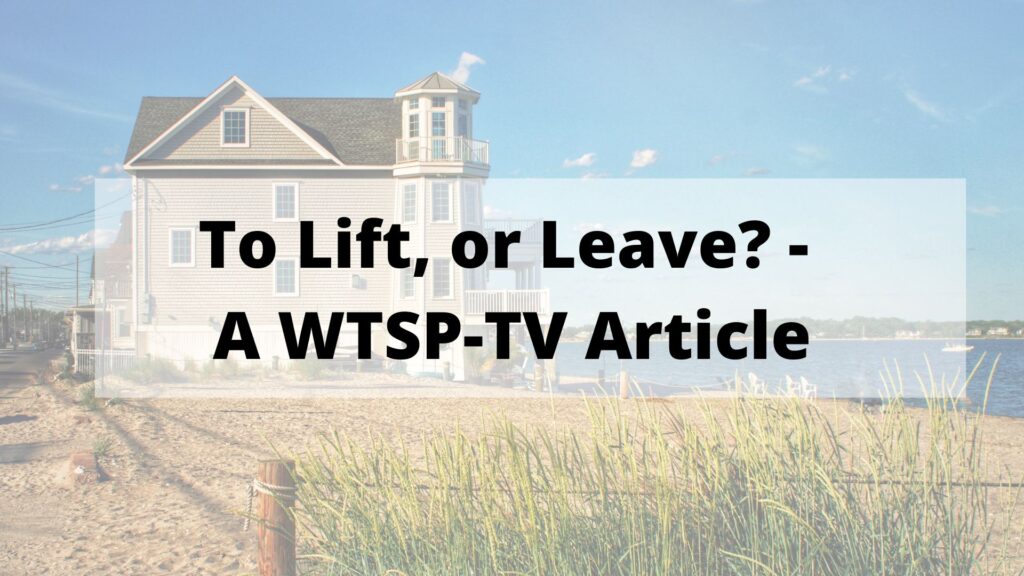
The Law Offices of John Caravella, P.C. does own this content. This content was created by Malique Rankin, and was published to the WTSP-TV. To view the full article, please click here:
After devastating flood waters entered into dozens of homes following Hurricane Idalia, many residents are weighing their options to avoid a repeat event.
ST. PETERSBURG, Fla. — As people across Tampa Bay are preparing for storms this weekend, residents of Shore Acres, a neighborhood in St. Pete, are reminded of the damage flood waters can do.
Following Hurricane Idalia, dozens of homes were destroyed as several feet of flood waters entered into homes. Many are still recovering and weighing their options for how to avoid a repeat scenario.
“We ended up having about six inches of water throughout the entire house,” Meghan Martin, a Shore Acres resident, said. “So we lost our appliances, cabinets, a lot of furniture, and possessions. We also had to tear out about four feet of drywall…”
Martin has lived in Shore Acres for seven years and Idalia was the second storm that brought flood waters into her home.
For the past few months, her family of six and her cats have been living in a one-bedroom condo while her home is repaired from flood damage.
“About 110 days,” Martin said. “Not that I’m counting”
This weekend, her family is finally moving back into their home. Next, they’ll begin the process of elevating the house 10 feet off the ground.
“It looks like our foundation is going to be one that they’re able to raise the foundation with the home and put columns underneath,” she explained. “And then they’ll pour a new foundation.”
Elevating your home not only protects it from the next flood, it can save you money in the long run.
“When you voluntarily elevate your home, you typically will reduce the cost of flood insurance. And that’s either through the federally backed National Flood Insurance Program or private flood ensures,” Mark Friedlander, the Florida spokesperson for the Insurance Information Institute said.
In some flood-risk areas, you need an elevated home just to qualify for flood insurance. You may wonder — why don’t people just sell instead of paying to put their homes on stilts?
“It’s probably going to be close to around $400,000,” Martin said. “So we do have to take basically a second mortgage to be able to pay for it.”
There’s a lot to factor in. The cost of homes now is likely more expensive than when a home was purchased years ago. If you’re taking a loss selling a home in a flood zone and paying more to move into a new home, it may not be your best option.
The Law Offices of John Caravella, P.C. does own this content. This content was created by Malique Rankin, and was published to the WTSP-TV. To view the full article, please click here:
John Caravella Esq., is a construction attorney and formerly practicing project architect at The Law Office of John Caravella, P.C., representing architects, engineers, contractors, subcontractors, and owners in all phases of contract preparation, litigation, and arbitration across New York and Florida. He also serves as an arbitrator to the American Arbitration Association Construction Industry Panel. Mr. Caravella can be reached by email: [email protected] or (631) 608-1346.
The information provided on this website does not, and is not intended to, constitute legal advice; instead, all information, content, and materials available on this site are for general informational purposes only. Readers of this website should contact their attorney to obtain advice with respect to any particular legal matter. No reader, user, or browser of this site should act or refrain from acting on the basis of information on this site without first seeking legal advice from counsel in the relevant jurisdiction. Only your individual attorney can provide assurances that the information contained herein – and your interpretation of it – is applicable or appropriate to your particular situation. Use of, and access to, this website or any of the links or resources contained within the site do not create an attorney-client relationship between the reader, user, or browser and website authors, contributors, contributing law firms, or committee members and their respective employers.
